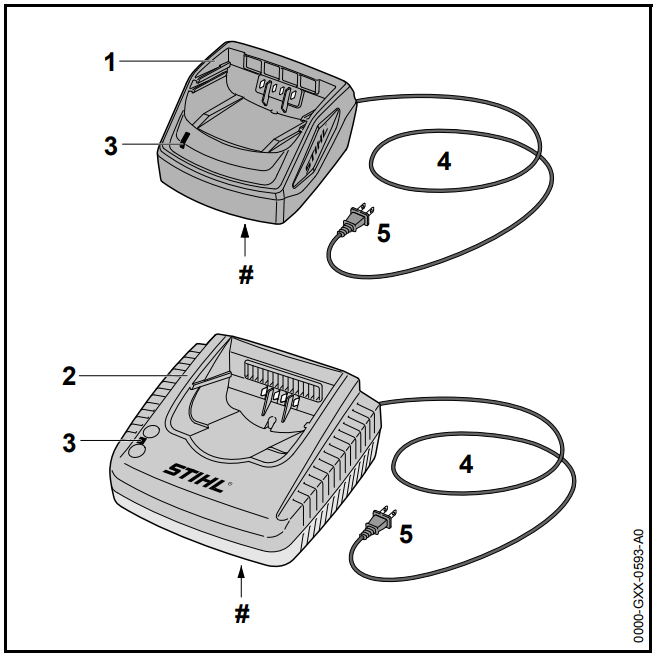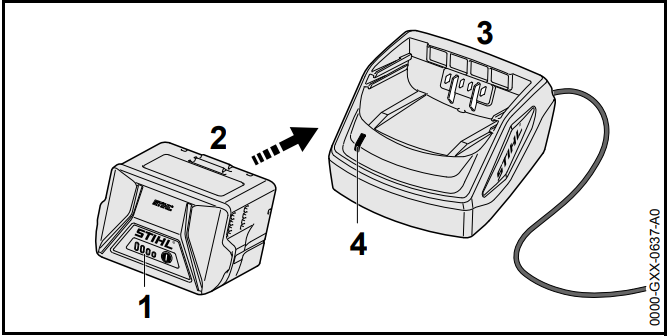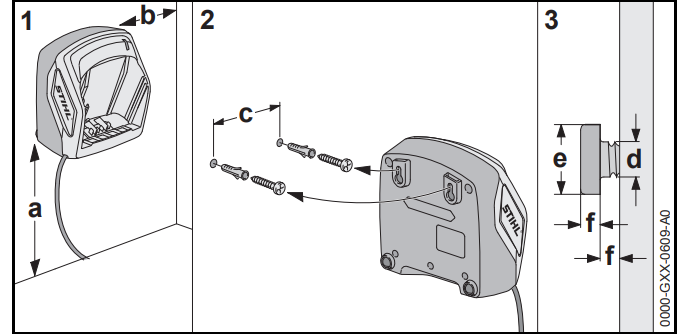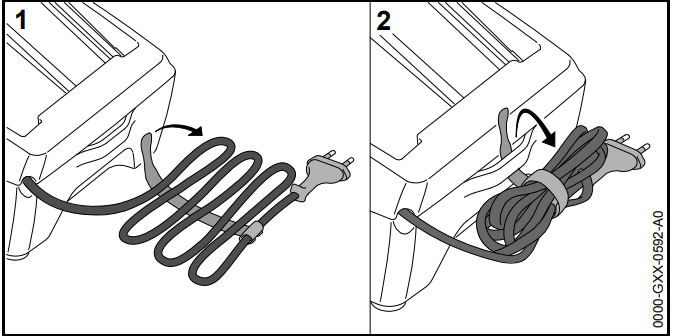Stihl Fast Battery Charger AL 500 Instruction Manual

Content
Introduction
The STIHL Fast Battery Charger AL 500 is an efficient charging solution designed to quickly power up STIHL's AP series batteries. With a rapid charging capability, it can fully charge a battery in about 30 minutes, making it ideal for professionals who require minimal downtime. The charger features a compact design and user-friendly interface, ensuring easy operation. Priced at approximately $99.99, it enhances productivity by keeping your tools ready for use at all times.
The information contained in this manual will help you receive maximum performance and satisfaction from your STIHL charger and, if followed, reduce the risk of injury from its use.
SAVE THIS MANUAL!
- Special safety precautions must be observed to reduce the risk of personal injury.
- Read this instruction manual thoroughly before use and periodically thereafter. Follow all safety precautions. Careless or improper use of the charger can cause serious or fatal injury.
STIHL Fast Battery Charger AL 500 MAIN PARTS
Charger

- Charger AL 101
Charges STIHL AK or STIHL AP series batteries. - Chargers AL 300 and AL 500
Charges STIHL AK, STIHL AP or STIHL AR series batteries. - Charger LED
Indicates the operating status of the charger. - Power Supply Cord
Supplies the charger with electricity when plugged into an electrical outlet. - Plug
Connects the power supply cord to an electrical outlet.
#Rating Plate
Contains electrical information and the product's serial number.
SAFETY SYMBOLS ON THE PRODUCTS
Charger
The following safety symbols are found on the charger:
 To reduce the risk of injury, follow the specified safety precautions.
To reduce the risk of injury, follow the specified safety precautions. Read and follow all safety precautions in the instruction manual. Improper use can lead to serious or fatal personal injury or property damage.
Read and follow all safety precautions in the instruction manual. Improper use can lead to serious or fatal personal injury or property damage. To reduce the risk of personal injury or property damage from fire or electric shock, keep the charger dry. Protect it from rain, water, liquids and damp conditions. For indoor use only, @ 5.
To reduce the risk of personal injury or property damage from fire or electric shock, keep the charger dry. Protect it from rain, water, liquids and damp conditions. For indoor use only, @ 5.
IMPORTANT SAFETY INSTRUCTIONS
Introduction
This section contains the prescribed general safety warnings and instructions for battery chargers. Additional important warnings and instructions are provided in subsequent sections of this manual.
READ ALL INSTRUCTIONS BEFORE USING THE CHARGER!
WARNING: When using battery chargers, basic safety precautions should always be followed to reduce the risk of fire, electric shock and personal injury and property damage, including the following:
- SAVE THESE INSTRUCTIONS – This manual contains important safety instructions for the STIHL AL 101, AL 300 and AL 500 battery chargers.
- Before using the battery charger, read all instructions and cautionary markings on the charger, battery and product using the battery.
- CAUTION – To reduce the risk of injury, use the STIHL AL 101 to charge only genuine STIHL AK or AP series batteries. Use the STIHL AL 300 and AL 500 to charge only genuine STIHL AK, AP or AR series batteries. Other types of batteries may burst causing serious personal injury and property damage.
Intended Use
WARNING
- The STIHL AL 101 charger is designed for charging STIHL AK and AP series batteries only.
- Improper use could result in personal injury or property damage, including damage to the charger.
- Use the charger only as described in this manual.
- Never attempt to modify or override the charger's controls or safety devices in any way.
- Never use a charger that has been modified or altered from its original design.
- The STIHL AL 300 and AL 500 chargers are designed for charging STIHL AK, AP and AR series batteries only.
Warnings and Instructions
- To reduce the risk of fire, electric shock and other personal injury or property damage:
- Before using the charger, read this instruction manual and all instructions and warnings on the charger, battery and product using the battery.
- Use the STIHL AL 101 to charge only genuine STIHL AK or AP series batteries. Other batteries may burst, catch fire or explode, resulting in personal injury and property damage.
- Use the STIHL AL 300 or AL 500 to charge only genuine STIHL AK, AP or AR series batteries. Other batteries may burst, catch fire or explode, resulting in personal injury and property damage.
- For indoor use only.
- Keep the charger dry. Protect it from rain, water, liquids and damp conditions. Never insert a wet battery or use a wet charger.
- Do not handle the charger, including power supply cord and plug, with wet hands.
- Never use a damaged charger.
- Never charge malfunctioning, damaged, cracked, leaking or deformed batteries.
- Never store a battery in the charger.
- Operate the charger only indoors, in dry rooms and within an ambient temperature range of 41 °F to 104 °F (5 °C to 40 °C).
- Keep the charger out of the reach of children.
- Always plug the charger into a properly installed electrical outlet matching the voltage and electrical frequency stated on the charger.
- Never use power strips to operate multiple chargers or other devices from the same outlet or on the same circuit.
- Do not operate a charger that has received a sharp or heavy blow, has been dropped or is otherwise damaged in any way.
- Do not attempt to repair, open or disassemble the charger. There are no user-serviceable parts inside.
- To reduce the risk of electric shock or fire from a short circuit:
- Make sure the battery and charger are completely dry before starting the charging process.
- Never bridge the contacts of the charger with wires or other metallic objects.
- Do not insert any objects into the charger’s cooling slots.
- The charger heats up during the charging process.
- To reduce the risk of fire:
- Do not operate on a combustible surface (e.g., paper, cardboard, textiles) or in a combustible environment.
- Allow the charger to cool down normally. Do not cover it.
- Chargers can produce sparks which may ignite combustible gases, liquids, vapors, dusts or other combustible materials.
- To reduce the risk of fire and explosion:
- Do not operate in a location where combustible gases, liquids, vapors, dusts or other combustible materials are present.
- Using a damaged power supply cord or plug may result in fire, electric shock and other personal injury or property damage.
- To reduce these risks:
- Check the charger’s power supply cord and plug regularly for damage. If damaged, immediately disconnect the plug from the electrical outlet.
- Have a damaged power supply cord replaced by an authorized STIHL servicing dealer.
- Unplug the power supply cord from the outlet when the charger is not in use.
- Never jerk the power supply cord to disconnect it from the electrical outlet. To unplug, grasp the plug, not the power supply cord.
- Do not use the power supply cord for carrying or hanging up the charger.
- Make sure the power supply cord is located or marked so that it will not be stepped on, tripped over, come in contact with sharp objects or moving parts, or otherwise be subjected to damage or stress.
- An extension cord should not be used unless absolutely necessary. Overloading an extension cord can result in overheating and fire.
- If an extension cord must be used:
- Use only a properly wired 16 gauge (AWG 16) or heavier gauge extension cord.
- Never connect more than one charger or other device to an extension cord.
- Never use an extension cord with a wattage rating lower than the wattage on your charger’s rating plate.
- Never use an extension cord if the blades on its plug are different from the blades on the charger plug in number, size or shape.
- Do not link (chain) extension cords.
- A typical household electrical circuit is between 15 and 20 amps. A single STIHL AL 500 charger draws approximately 4.8 amps. A single AL 300 draws approximately 4.4 amps and an AL 101 approximately 1.3 amps.
- To reduce the risk of fire from overloading an electrical circuit:
- Ensure the electrical system is rated to withstand the expected electrical draw before charging your battery.
- Charge multiple batteries one at a time or on separate circuits, unless you know your circuit can handle the total expected draw from multiple chargers.
- In case of fire, or if the charger or the battery it is charging emits smoke, an unusual smell, feels hot or appears abnormal in any other way:
- Immediately disconnect the charger from the outlet and prepare to contact the authorities in the event of fire or explosion.
- To reduce the risk of electric shock and other personal injury or property damage when mounting the charger:
- Ensure that no electrical cables, pipes or other service lines run behind the wall where the charger is to be mounted.
- Mount the charger only as described in this manual.
- Remove the battery before mounting the charger.
SPECIFICATIONS
STIHL AL 101, AL 300, AL 500
- Mains voltage: See rating plate
- Rated current: See rating plate
- Frequency: See rating plate
- Charging current: See rating plate
- Rated power: See rating plate
- Insulation: See rating plate
- Permissible ambient temperature range during charging: 41 °F to 104 °F (5 °C to 40 °C)
WARNING
- A typical household electrical circuit is between 15 and 20 amps. A single STIHL AL 500 charger draws approximately 4.8 amps. A single AL 300 draws approximately 4.4 amps and an AL 101 approximately 1.3 amps. To reduce the risk of fire from overloading an electrical circuit:
- Ensure the electrical system is rated to withstand the expected electrical draw before charging your battery.
- Charge multiple batteries one at a time or on separate circuits, unless you know your circuit can handle the total expected draw from multiple chargers.
| Symbol | Explanation |
| V | Volt |
| Hz | Hertz |
| A | Ampere |
| W | Watt |
| AC | Alternating current |
| IP20 | Degree of electrical protection |
| X | The power supply cord can be replaced by an authorized STIHL servicing dealer. |
Symbols on the Charger
 Direct current
Direct current Fuse
Fuse Read the manual
Read the manual Insulation: Class II (Double Insulation)
Insulation: Class II (Double Insulation) Use and store charger only indoors in dry rooms
Use and store charger only indoors in dry rooms Certification/listing mark of CSA
Certification/listing mark of CSA California Energy Commission. This battery system complies with the California Energy Commission efficiency requirements.
California Energy Commission. This battery system complies with the California Energy Commission efficiency requirements. Manufacturer Code
Manufacturer Code
Engineering Improvements
STIHL's philosophy is to continually improve all of its products. As a result, engineering changes and improvements are made from time to time. Therefore, some changes, modifications and improvements may not be covered in this manual. If the operating characteristics or the appearance of your machine differs from those described in this manual, please contact your STIHL dealer or the STIHL distributor in your area for assistance.
REPLACEMENT PARTS AND EQUIPMENT
Genuine STIHL Replacement Parts
STIHL recommends the use of genuine STIHL replacement parts. Genuine STIHL parts can be identified by the STIHL part number, the logo and, in some cases, by the STIHL parts symbol . The symbol may appear alone on small parts.
MAINTENANCE, REPAIR AND STORAGE
Warnings and Instructions
WARNING
- There are no user-authorized repairs for the charger. To reduce the risk of fire, electric shock or other personal injury and property damage:
- Do not attempt to repair, open or disassemble the charger. There are no user-serviceable parts inside.
- Users may carry out only the cleaning and maintenance operations described in this manual.
- To reduce the risk of electric shock:
- Unplug the charger from the electrical outlet before inspecting or cleaning the charger.
- Regularly check the electrical contacts of the charger and ensure that the insulation of the power cord and plug are in good condition and show no signs of aging (brittleness), wear or damage.
- Have a damaged power supply cord replaced by an authorized STIHL servicing dealer.
- Improper storage can result in unauthorized use, damage to the charger, and an increased risk of fire, electric shock and other personal injury or property damage.
- Never store the charger with the battery inserted.
- Before storing, always unplug the charger from the electrical outlet and remove the battery.
- Store the charger indoors in a dry, secure place that cannot be accessed by children or other unauthorized users.
SAVE THESE INSTRUCTIONS
CHARGING THE BATTERY
Setting up the Charger
WARNING: Read and follow the safety precautions on the battery and charger and the warnings and instructions in this manual, To reduce the risk of short circuit, which could lead to electric shock, fire and explosion, make sure the charger and its components are dry and not damaged; operate the charger indoors at an appropriate ambient temperature,
WARNING: Since the battery and charger heat up during the charging process, do not operate the charger on a combustible surface or in a location where combustible gases, liquids, vapors, dusts or other materials are present.
To set up the charger:

- Insert the plug (3) into a properly installed wall outlet (4) matching the voltage and electrical frequency stated on the rating plate on the charger.
- The charger runs a self-test immediately after it is plugged in. The LED (1) will glow green for about 1 second, then it will glow red briefly before going out. Once the LED goes out, the self-test is complete and the charger is ready to charge the battery.
- Position the power supply cord (2) so that it will not be stepped on, tripped over, come in contact with sharp objects or moving parts or otherwise be subjected to damage or stress.
Charging
WARNING: STIHL batteries contain safety features and devices which, if damaged, may allow the battery to generate heat, rupture, leak, ignite or explode. Never charge a malfunctioning, damaged, cracked, leaking or deformed battery or use a charger that has been damaged Make sure the charger and the battery to be charged are both completely dry before charging. Follow all product-specific warnings and instructions accompanying your battery.

- Push the battery (2) into the charger (3) until it stops. The LED on the charger glows green when the battery is charging.
- The LEDs (1) on the battery glow green and show the state of charge.
- When the LEDs on the battery go out, the charging process is complete and the charger will shut itself off. The battery can be removed from the charger.
- Disconnect the power supply cord from the electrical outlet when the charger is not in use.
A battery is not fully charged when it ships from the factory. STIHL recommends that you fully charge the battery before using it the first time. The STIHL AL 300 and AL 500 chargers are equipped with an integrated fan. The fan may switch on and off automatically while charging the battery.
Operate the charger only indoors, in dry rooms and within an ambient temperature range of 41 °F to 104 °F (5 °C to 40 °C). The battery heats up during operation. If a hot battery is inserted into the charger, it may be necessary for it to cool down before charging starts. The charging process begins only after the battery has cooled down sufficiently. Charging time depends on a number of factors, including battery condition and the ambient temperature.
Mounting the Charger on a Wall
Before mounting, ensure that no electrical cables, pipes or other service lines run in the wall behind the charger.
To mount the wall charger:

- Mount the charger indoors in a dry room near an electrical outlet.
- Sink the screws into a wall stud. Use appropriate screw-in wall anchors or other similar mounting devices if an appropriate wall stud is not available.
- Align the charger as shown above. Mount to a wall with the following dimensions:
- = minimum 18 in. (450 mm)
- = minimum 3.9 in. (100 mm)
- (for AL 101) = 3.0 in. (75 mm) (for AL 300 and AL 500) = 4.7 in. (120 mm)
- = 0.2 in. (4,5 mm)
- = 0.4 in. (9 mm)
- = 0.1 in. (2,5 mm)
Description
The STIHL Fast Battery Charger AL 500 is engineered to provide rapid and reliable battery charging. Its sleek design ensures it fits seamlessly into any workspace, whether in a professional setting or at home. The charger features LED indicators that provide real-time updates on the charging status, allowing you to monitor the process effortlessly. With overcharge protection, you can trust that your batteries will be charged efficiently without compromising their longevity.
LED DIAGNOSTICS of STIHL Fast Battery Charger AL 500
LED on the Charger
One LED shows the status of the charger. The LED can glow green or flash red.
 If the LED glows green continuously: the battery is being charged.
If the LED glows green continuously: the battery is being charged.
or- The battery is too hot or too cold for charging. To determine, check the LEDs on the battery. If there is one glowing red light, allow the battery to warm up or cool down gradually at an ambient temperature of about 50 °F to 68 °F (10 °C to 20 °C).
 If the LED flashes red: there is no electric contact between the battery and the charger. Remove and reinsert the battery.
If the LED flashes red: there is no electric contact between the battery and the charger. Remove and reinsert the battery.
or- The battery has a malfunction and must be replaced. Check the LEDs on the battery. Do not use or charge a battery if its LEDs indicate a malfunction.
or - The charger has a malfunction. Have it checked by an authorized STIHL servicing dealer before use.
- The battery has a malfunction and must be replaced. Check the LEDs on the battery. Do not use or charge a battery if its LEDs indicate a malfunction.
Setup Guide
To operate the STIHL Fast Battery Charger AL 500:
- Connect the Charger:** Plug the charger into a standard electrical outlet.
- Insert the Battery:** Place the battery into the charging slot, ensuring it clicks securely into place.
- Monitor Charging:** Use the LED indicators to track the charging progress.
- Remove and Use:** Once fully charged, remove the battery and it's ready for use.
TRANSPORTING
Charger
To properly transport the charger:
- Disconnect the charger from the electrical outlet.
- Remove the battery from the charger.
- Wrap the power supply cord and attach it to the charger.
- When transporting the charger in a vehicle, secure and position the charger to prevent turnover, impact and damage.
STORING
Charger
To properly store the charger:
- Remove the battery from the charger.
- Disconnect the charger from the electrical outlet.

- Wrap the power supply cord and attach it to the charger.
- Store the charger indoors in a dry and secure location.
- Keep it out of the reach of children and other unauthorized persons.
INSPECTION AND MAINTENANCE
Charger
WARNING: To reduce the risk of personal injury from short circuit and fire, do not attempt to repair, open or disassemble the charger. There are no user-serviceable parts inside. Always unplug the charger before cleaning.
To properly care for your charger:
- Keep the charger housing and electrical contacts free from foreign matter.
- Clean the charger as necessary with a dry cloth or soft, dry brush.
- Have a damaged power supply cord replaced by an authorized STIHL servicing dealer.
- Have worn, missing or damaged safety labels replaced by an authorized STIHL servicing dealer.
If you make a warranty claim for a component that has not been serviced or maintained properly, coverage may be denied.
Troubleshooting
| Condition | LEDs on Charger | Cause | Remedy |
| LED on charger flashes red. | LED flashes red. | No electrical contact between charger and battery. |
|
Malfunction in battery. |
If 4 LEDs on the battery are flashing, it has a malfunction and must be replaced. Otherwise, have the battery checked by an authorized STIHL servicing dealer. | ||
Malfunction in charger. |
| ||
The charger does not run a self test. | The LED glows not green for about 1 second and then red for about 1 second. | Electrical contact to charger was briefly interrupted. |
|
STIHL Fast Battery Charger AL 500 Pros & Cons
Pros
- Rapid Charging: Quickly recharges batteries, reducing downtime.
- Compact and Lightweight: Easy to transport and store.
- LED Indicators: Clear and convenient charging status updates.
- Overcharge Protection: Extends battery lifespan by preventing overcharging.
Cons
- Limited Compatibility: Only compatible with specific STIHL batteries.
- No Cooling System: May not be suitable for continuous heavy-duty use.
- Higher Cost: Compared to standard chargers, though justified by faster charging times.
Customer Reviews
Customers have praised the STIHL Fast Battery Charger AL 500 for its efficiency and reliability. Many users appreciate the rapid charging times, which significantly reduce downtime between jobs. However, some have noted that it is only compatible with specific STIHL batteries, which may limit its use for those with mixed tool sets. Despite this, the overall consensus is that it provides excellent value for those invested in the STIHL ecosystem.
Common complaints include the higher cost compared to standard chargers and the lack of a cooling system, which might be a concern for heavy-duty users.
WARRANTY
STIHL Incorporated Limited Warranty Policy
This product is sold subject to the STIHL Incorporated Limited Warranty Policy, available at https://www.stihlusa.com/warranty.html
Faqs
What type of batteries is the STIHL Fast Battery Charger compatible with?
How long does it take to fully charge an AP 300 battery with the charger?
Does the AL 500 have overcharge protection?
What are the LED indicators on the AL 500 charger used for?
Is the STIHL Fast Battery lightweight and easy to transport?
How do I troubleshoot if my AL 500 charger is not turning on?
Can I use the Charger continuously without cooling?
Are there any specific safety precautions I should follow when using the AL 500 charger?
Leave a Comment
